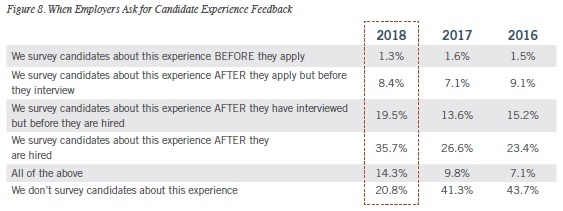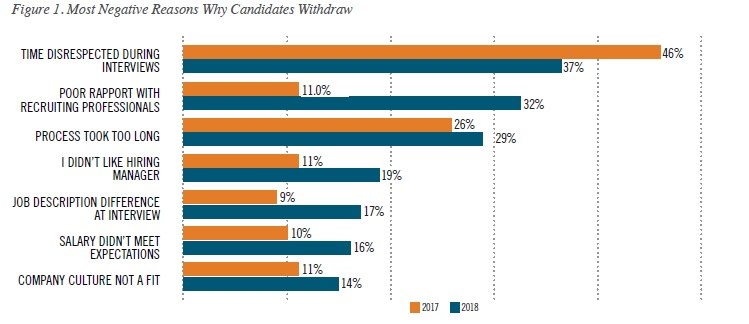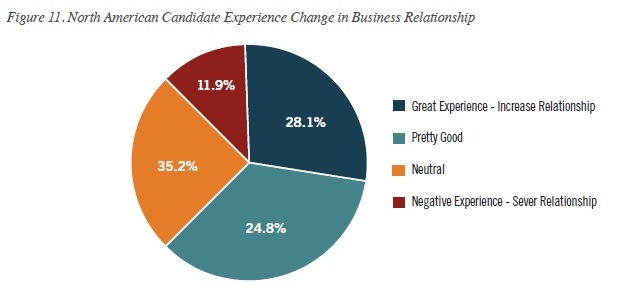Candidates: Are you interviewing and need support?
Every year the Talent Board surveys more than 100,000 candidates applying to roles at 200 companies. The resulting research report is the most comprehensive annual study of candidate experience.
Let’s dig into what’s improving, what’s moving in the wrong direction, and other important trends that came out of the report.
What’s Improving?
There’s a lot that’s getting better for the average candidate.
1) More Opportunities to Share Feedback than Ever Before
Candidates are receiving the opportunity to share more feedback across the hiring process than ever before. Effectively every survey opportunity is up year-over-year from 2017.

The most striking thing here is the percent of employers who don’t survey their candidates about the experience. In years past this number hovered a little below half; in 2018, just 20.8% of employers said they were not surveying candidates about their experience.
This is a huge shift, and a critically important one. Without existing survey data from candidates, attempts to improve their experience are a shot in the dark. You have no way of knowing if a new process, approach, or technology is working, because you haven’t asked the people that matter. Candidate surveys set the stage for evaluating what’s working, what’s not, and how to continually improve.
2) Time to Complete Online Applications is Shrinking
Last year, we saw this number move in the wrong direction. Only 20% of candidates reported that their application took under 15 minutes to complete, down from 26% in 2016.
This year we saw that trend reverse in fairly dramatic fashion: 36.6% of candidates said their application took less than 15 minutes.
| 2018 | 2017 | 2016 | |
| Percent of Applicants Who Took <15 Minutes | 36.6% | 20% | 26% |
This is a step in the right direction on a number of different levels. Very few candidates enjoy filling out forms; minimizing the time they spend doing so is pretty clearly a better experience. The information on an application is also some of the least predictive when it comes to predicting actual job performance. If candidates are going to spend 30 or so minutes interacting with your brand, a validated pre-hire assessment is a much better option.
3) Mobile Apply is at an All-Time High
Speaking of the job application, employers offering a mobile-enabled application is at an all-time high. Last year we saw this jump from 79% to 91%; in 2018, it pushed up to 93%. We’re probably reaching a saturation point here, with only a few legacy ATSs lagging behind.
| 2018 | 2017 | 2016 | 2015 | |
| Percent of Employers Offering Mobile Apply | 93% | 91% | 79% | 67% |
Interestingly, only 18.4% of candidates took advantage of this feature. Which is still a substantial portion of an applicant pool, but not really in line with mobile usage numbers we see at other parts of the hiring process (for example, ~45% of HireVue OnDemand interviews are completed on mobile).
What’s Moving in the Wrong Direction
Now the “not so good” trends in candidate experience.
1) Feedback for Candidates is Less than Stellar
While more candidates than ever are getting the opportunity to provide feedback, the same can’t be said when the feedback is going the other direction.
46% of candidates did not hear back from employers 2 months after they applied.
This number hasn’t budged since 2017, or even 2016. While many of these were likely unqualified for the role they applied for, this is a huge missed opportunity. Applicants who are unqualified for certain roles may be a perfect fit for others (and may simply be confused by poorly-worded job titles and descriptions), and are frequently customers.
2) “Poor Rapport With Recruiting Professionals” Becomes a Major Reason Candidates Withdraw from the Hiring Process
Last year, 72% of candidates who withdrew from the recruiting process did so for one of two reasons:
- Time Disrespected During Interviews (46%)
- Process Took Too Long (26%)
This year, the second-most cited reason for withdrawal seemingly came out of nowhere (last year it was the fifth-most cited reason): Poor Rapport With Recruiting Professionals.

This is an interesting development, least of which because we’ve seen time to fill - in aggregate - increase in 2018. So while it’s taking longer to hire, more candidates indicate that a poor experience with members of recruiting staff leads to withdrawal.
We should also note that the numbers here are up across the board (the question allows for multiple selections), so the reasoning behind a withdrawal is more multifactorial than in previous years.
Again, this is an area where surveying candidates becomes critical. It seems unlikely that recruiting teams became less pleasant overnight; so fixes here will be highly individualized for each organization.
3) Time to Offer Post-Interview is Stagnant
After a candidate’s final interview, the clock starts ticking. Candidates generally lose interest in a job within two or so weeks post-interview. For the past three years, the time candidates spend in limbo has stagnated.

Given how little these numbers have moved over the past three years, this is an excellent opportunity for ambitious TA teams to gain a speed advantage over their competitors.
Other Important Trends
Beyond what’s getting better and what’s getting worse, these are other key trends to emerge from this year’s CandE Report.
1) Candidate Experience Delivers Provable ROI
Proving the ROI of a candidate experience initiative has always been a bit nebulous. This year, the folks at the Talent Board provided an interesting framework to build a business case for the candidate’s experience. Basically, the math goes like this:

Here’s a walkthrough through the numbers:
- 0.15 (second step): very positive job candidates are projected to increase their average annual spend by 15% (per consumer research)
- 0.14 (third step): 14% of candidate respondents said they were customers of the company they applied to (CandE Research Report data)
- 0.28 (third step): 28% of candidate respondents said they would increase their business relationship with the employer (CandE Research Report data)
For example, if a company’s average revenue generated per customer is $100 per year, and they reject 100,000 candidates a year, they should expect their candidate experience to influence ~$58,800 in new revenue (100,000 * (100*0.15) * (0.14*0.28)).
Of course, there are a number of assumptions built into this calculation, but it’s useful to have a starting benchmark. It’s also important to keep in mind that these are aggregate numbers - a better candidate experience will have an increased benefit, and a worse one may have a negative impact.
 How candidates overall perceived their experience in 2018.
How candidates overall perceived their experience in 2018.
2) Emerging Methods of Engaging Candidates Gain Ground
Video job descriptions are a great way to give candidates a more realistic job preview and clear up any questions they may have after reading through a traditional job description. Only 50% of candidates surveyed by the Talent Board said that the job description was valuable (down from 55% in 2017, and from 77% in 2014), so this is clearly an area for improvement.
60% of employers said they were considering video job descriptions for 2019.
On the outreach side of things, we saw a dramatic leap in the percentage of recruiting teams who reported using texting. Last year, 28% of TA teams said they were leveraging texting to interact with candidates. This year, that number jumped to 48%. It’s well known that texting delivers very high read rates (98% is the number usually cited), so this leap makes sense as the job market remains hot.
3) Other Benchmark Stats
Some other interesting benchmark stats to come out of the Talent Board’s latest research report include:
- 92% of candidates did not get hired
- ⅓ - ½ of candidates who apply for all position types are not qualified
- Candidates cited “Company Values” as the most useful marketing content (44%)
- 81% of companies use Facebook and 78% use Twitter to cater to candidates; only 17% of candidates use Facebook and 4% use Twitter to search for jobs
Get the full research report from the Talent Board here. Or check out our comprehensive guide to candidate experience.





